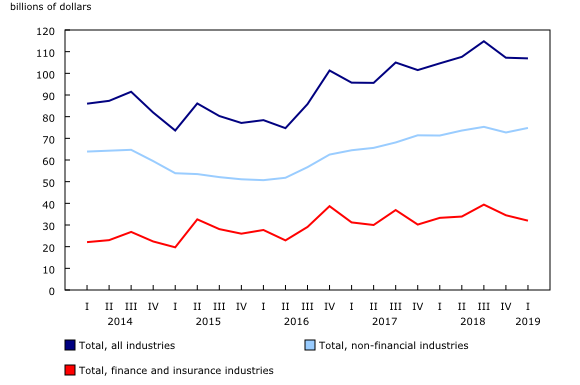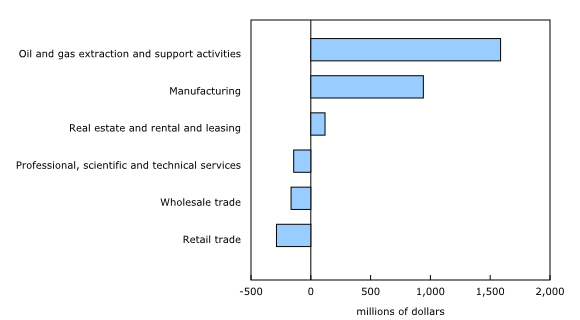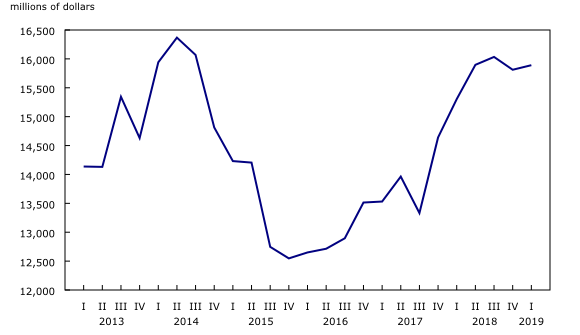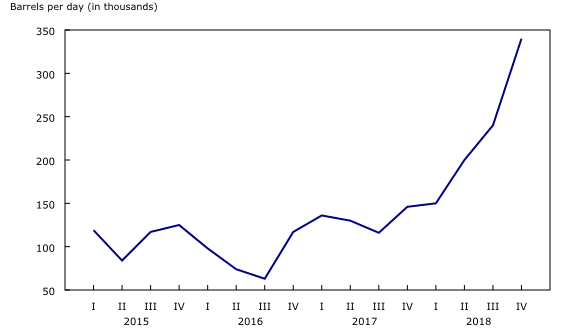Quarterly financial statistics for enterprises, first quarter 2019
Archived Content
Information identified as archived is provided for reference, research or recordkeeping purposes. It is not subject to the Government of Canada Web Standards and has not been altered or updated since it was archived. Please "contact us" to request a format other than those available.
Released: 2019-05-24
$106.9 billion
First quarter 2019
-0.3% 
(quarterly change)
Overall operating profits
Canadian corporations earned $106.9 billion in operating profit in the first quarter, edging down $322 million or 0.3% from the fourth quarter of 2018 but 2.2% higher compared with the first quarter of 2018.
Non-financial industries
In the non-financial industries, operating profit increased $2.1 billion (+3.0%) from the fourth quarter of 2018 to $74.8 billion. Overall, operating profit was up in 9 of 17 non-financial industries.
Compared with the first quarter of 2018, operating profit for Canadian non-financial enterprises increased 5.0% in the first quarter.
Operating profit increases in the oil and gas extraction and support activities industry
Operating profits in the oil and gas extraction and support activities industry increased $1.6 billion in the first quarter, going from a loss of $678 million in the fourth quarter of 2018 to a profit of $909 million. This increase was attributable to a rise in oil prices.
Operating profit up in manufacturing
Operating profit for manufacturing industries grew $941 million (+6.4%) from the fourth quarter to $15.7 billion, as 10 of 13 industries increased.
Operating profit for motor vehicle and parts manufacturing led the increase, rising $606 million from the fourth quarter of 2018, to $1.5 billion in the first quarter due to higher sales.
Operating profit for petroleum and coal products manufacturing increased $151 million (+5.6%) from the fourth quarter due to higher oil prices.
Operating profit down in retail and wholesale trade
In retail trade, operating profit decreased by $287 million (-4.5%) from the fourth quarter of 2018 to $6.0 billion in the first quarter. Clothing, department and other general merchandise stores led the decline, down $291 million (-16.6%).
In wholesale trade, operating profit decreased by $165 million (-1.8%) to $9.2 billion in the first quarter. This decline was mostly attributable to other merchant wholesalers, down $432 million (-11.9%).
Operating profit down in the financial industries
Operating profit in the financial industries declined by $2.5 billion (-7.2%), down from $34.5 billion in the fourth quarter of 2018 to $32.0 billion in the first quarter.
Operating profit for depository credit intermediation decreased $2.7 billion (-18.1%) to $12.4 billion. Banking and other depository credit intermediation led the decline, as their operating profits were down $2.6 billion (-18.4%) to $11.4 billion. This is attributable to an increase in expenses (+11.2%) due to a non-recurrent payment to external business partners.
Operating profit for insurance carriers and related activities rose $44 million (+2.1%) from the fourth quarter of 2018 to $2.1 billion in the first quarter. Agencies, brokerages and other insurance related activities industry led the increase, up $150 million.
The effect of the Western Canadian Select-West Texas Intermediate differential on inventories of enterprises in the oil industry
The inventories reported in the Quarterly Survey of Financial Statements for enterprises that are in the oil and gas extraction and support activities (NAICS 21C) and the petroleum and coal products manufacturing (NAICS 324) industries have been showing an upward trend in 2018. They went from $15.3 billion in the first quarter of 2018 and reached their highest levels in the third quarter of 2018 at $16.0 billion (+4.8% over that time period). The effect of the widening of the Western Canadian Select-West Texas Intermediate (WCS-WTI) differential seemed to have contributed to this growth in inventories.
The Western Canada Sedimentary Basin (WCSB) is the major crude oil producing region in Canada. Crude oil production from the WCSB comes primarily from the oil sands. The main heavy oil benchmark price for crude produced in Western Canada is the WCS, which is priced in Alberta. This price is often reported relative to the North American light crude oil benchmark, the WTI, which is priced in Oklahoma.
The difference between the two benchmark prices is referred to as the WCS-WTI differential. When the WCS price is lower than WTI, the differential is negative, and it is referred to as a discount.
In the first quarter of 2018, the WCS-WTI differential started widening further than usual, and reached its widest level in at least four years in the fourth quarter of 2018. This meant that Canada received a lower price for its oil than usual, which affected many enterprises that are part of the Canadian oil supply chain.
The widening of the WCS-WTI differential could be attributed to a growing supply of oil in 2018, together with challenges in the means of transportation. Oil producers of Western Canada had to use additional methods to transport their oil to market by using the rail option to the Gulf of Mexico, since this region offers the best price for the WCS.
In addition, in the third quarter of 2018, there was maintenance at refineries in the US Midwest, the largest importer of WCS, which reduced the demand for Canadian oil, putting downward pressure on prices and ultimately widening the WCS-WTI differential even more.
It seemed that as pipelines and railcars reached their full capacity, producers could not get their crude oil to market and had to put barrels into storage tanks. Ultimately, this translated into higher inventories in the balance sheet of Canadian enterprises in the oil and gas extraction and support activities and the petroleum and coal products manufacturing industries.
Note to readers
Data on quarterly profits in this release are seasonally adjusted and expressed in current dollars. Quarterly financial data for the period covering the first quarter of 2016 to the fourth quarter of 2018 have been revised following the reconciliation to the 2016 and 2017 annual series.
For information on seasonal adjustment, see Seasonally adjusted data – Frequently asked questions.
Quarterly financial statistics for enterprises are based on a sample survey and represent the activities of all corporations in Canada, except those that are government-controlled or not-for-profit. An enterprise can be a single corporation or a family of corporations under common ownership and/or control, for which consolidated financial statements are produced.
Profits referred to in this analysis are operating profits earned from normal business activities. For non-financial industries, operating profits exclude interest and dividend revenue and capital gains/losses. For financial industries, these are included, along with interest paid on deposits.
In this release, all profits are operating profits unless otherwise stated. Operating profits differ from net profits, which represent the after-tax profits earned by corporations.
For more details on the concept of actuarial liabilities, consult the page Actuarial liabilities.
As of January 1, 2019, a new accounting standard on leases came into effect. Enterprises preparing their financial statements in accordance with International Financial Reporting Standards (IFRS) will start adopting the new IFRS 16 which requires lessees to recognize most leases on their balance sheet. This may translate into increases in their level of assets and liabilities due to the inclusion of existing and new leases in their balance sheet in accordance with the new standard.
Real-time tables
Real-time tables 33-10-0160-01 and 33-10-0161-01 will be updated on June 10. For more information, consult the document Real-time tables.
Next release
Financial statistics for enterprises for the second quarter will be released on August 23.
Products
Aggregate balance sheet and income statement data for Canadian corporations are now available.
Data from the Quarterly Survey of Financial Statements are also available.
Contact information
For more information, or to enquire about the concepts, methods or data quality of this release, contact us (toll-free 1-800-263-1136; 514-283-8300; STATCAN.infostats-infostats.STATCAN@canada.ca) or Media Relations (613-951-4636; STATCAN.mediahotline-ligneinfomedias.STATCAN@canada.ca).
- Date modified:





